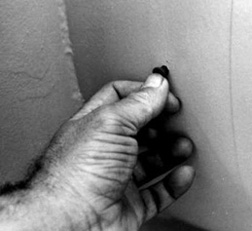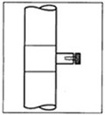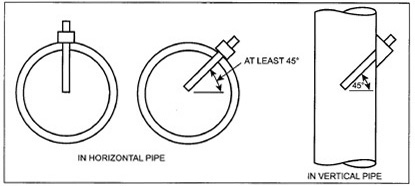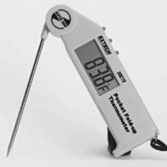To measure temperature and humidity properly, the technician must be able to use all of the following instruments:
Measuring Temperatures
AccuracyCatalog descriptions of thermometers usually give their accuracy. For analog instruments, accuracy is usually given as a percentage of the scale. A typical designation is "±1 percent of scale." This means that a 0 degree F to 120 degree F thermometer is accurate to within ±1.2 degrees (1 percent of 120 degrees F). In other words a reading of 70 degrees F can actually be between 68.8 degrees F and 71.2 degrees F.
This article gives the general accuracy for a type of instrument. However, the accuracy can vary from one model to another. Check with the manufacturer for the accuracy of a particular instrument.
Divisions
Whenever you use a different analog thermometer, be sure to check what the divisions mean. For example, on some thermometers a single division means 1 degree. On others a division means 2 degrees.



Thermometers
Glass Stem ThermometerThe portable glass stem thermometer is seldom used on the job because of the chance of breakage. However, it cannot get out of calibration and is often used to check the accuracy of other types of thermometers.
Glass stem test thermometers are usually mercury-filled, and 14 inches to 16 inches long. They should be the partial-immersion type - that is, they must only be immersed in the liquid up to the mark on the stem. Some thermometers are alcohol-filled instead of mercury to avoid mercury contamination if the thermometer is broken.
Thermometer subdivision marks are usually either 1-degree or 2-degree increments. Markings should be engraved on the glass, so that they do not wear off with use. Be aware of parallax if the thermometer is located where your eyes are not on a plane with the meniscus.

Pocket thermometers are convenient since they are about as long as a pen and can clip into a shirt pocket. Due to the small scale, accurate readings are difficult to obtain. They get out of calibration easily.
The analog dial thermometer (Figure 4) is a bi-metal thermometer that contains a strip made of two layers of different metals. The different expansion rates of the two metals cause the strip to bend and this moves the indicator on the dial. However, they take some time for the indicator to reach the final point. Figure 4 shows a single scale thermometer with a 1-inch diameter dial.
Pocket dial thermometers often have a lock nut at the back of the dial. Loosen this nut to twist the dial in order to calibrate it. Compare it with a glass stem thermometer or place in a glass of water and ice, which will be at 32 degrees F (0 degrees C). Because of this calibration feature, do not twist the thermometer when holding it by the dial while inserting into a PT plug.

Digital Thermometers
Digital thermometers are battery powered. They are highly accurate and provide a choice between degrees F and degrees C scales. A variety of probes can be used for different applications such as penetration, surface, or air measurements. Most of these instruments can be calibrated in the field by placing the probe in the socket on the instrument and then zeroing the readout.
Surface Thermometers
It is always better to use an immersion thermometer to measure the temperature of a liquid. However, if there is no practical way to enter a hydronic system to measure the fluid directly, a surface thermometer can be used. It is held to the surface of the pipe either by a magnet or by a spring that wraps around the pipe. In some cases, they may have to be held in place by hand.
The surface temperature of the pipe will not be the same as the temperature of the liquid in the pipe. However, if readings are taken on the same type of pipe for each point, the temperature difference (delta T) across a device can be determined. Be sure the pipe surface is clean.

A non-contact infrared thermometer (Figure 6) is used to measure temperatures in hard-to-reach places, such as the air temperature at a high supply air outlet that would otherwise require a special ladder or scaffold. Other typical uses are checking the temperature differential on each side of a steam trap, the temperature of a high voltage panel, the temperature of moving parts such as motor bearings, or hot spots on a building because of poor insulation.
Infrared thermometers have digital displays and most can be selected for either degrees F or degrees C. They are generally accurate to ±2 degrees F (±1 degree C). Many use a laser beam to indicate the target area that is being measured. Features vary widely, depending on the model.
In addition to the accuracy, an important feature to check is the target or spot size. The optical system varies with different models, so that the diameter of the spot being measured will vary with the distance. For example, one model specifies an 8-inch diameter spot at 60-inch distance from the target.
Psychrometers
Psychrometers are used to determine relative humidity by measuring dry bulb and wet bulb temperatures. The relative humidity (rh) is determined based upon the measured wet bulb and dry bulb temperatures. Relative humidity is an important factor in determining the comfort conditions of a space.Relative humidity is the percentage of moisture in the air as compared to the total amount of moisture that air can hold at a specific temperature, which is 100 percent humidity.
Sling Psychrometer
A sling psychrometer is the basic method of determining relative humidity. It consists of a dry bulb and a wet bulb thermometer. The wet bulb thermometer has a wick on the bulb that is wetted at each use. After the wick is wetted, the thermometers are whirled in the air for two minutes. Then the dry bulb and the wet bulb temperatures are read. The relative humidity is determined from these readings by use of a scale attached to the instrument or by a psychrometric chart.
For most HVAC work, the sling psychrometer has been replaced by power psychrometers that are faster, easier to use, and more accurate.

A power psychrometer (Figure 7) is a battery operated, analog instrument that has accurate dry bulb and wet bulb thermometers. Some have a built-in water bottle to keep the wet bulb wick wet. A battery-powered fan maintains a constant proper velocity of air across the wick. A psychrometric chart on the instrument is used to determine rh and dew point (the temperature at which water starts condensing out of the air.)
This instrument is more accurate than the sling psychrometer because the air velocity across the wet bulb is constant, and because the wet bulb temperature can be read as soon as it stabilizes. On the sling psychrometer, the time between stopping the whirling and reading the wet bulb temperature can be long enough for the wet bulb temperature to change significantly.
The accuracy of the power psychrometer is generally ±1 percent of the full scale. This means that on a scale that reads from 0 degrees to 120 degrees F, the instrument is accurate to ±1.2 degrees F.
Digital Psychrometers
A digital psychrometer is fast and provides the dry bulb temperature within one second and the wet bulb temperature within 15 seconds. Its accuracy is generally ±2 degrees F.
There are a variety of instruments called thermo-hygrometers or temperature/humidity/dew point indicators. These operate electronically and provide temperatures and dew points in addition to relative humidity. Many of these can be connected to a handheld printer.
Temperature And Humidity Recorders
A temperature recorder records variables such as temperature, humidity, and dew point with a continuous line on a replaceable circular chart or strip. A recorder is installed when a record is needed over a given period of time. Probes are placed in the location that is to be measured. The time period to be recorded can be set from a keypad and can range from 24 hours up to 31 days. Most recorders can be programmed to record two values at a time - choosing from dry bulb temperature, wet bulb temperature, dew point, or humidity. Recorders can be battery operated or key wound.Other Recorders
Recorders are available for other values such as differential pressure, level of carbon dioxide, and electrical values.Excerpted and reprinted from Instruments For HVAC Work by Leo A. Meyer, one of the books in the Indoor Environment Technician's Library series published by LAMA Books. For over 30 years, Meyer has been writing and publishing training materials for the HVAC industry. His books cover a wide range of topics, including heating and cooling, indoor air quality, sheet metal work, electricity basics, safety, and others. For more information, visit www.lamabooks.com.
Publication date: 04/04/2005

Report Abusive Comment